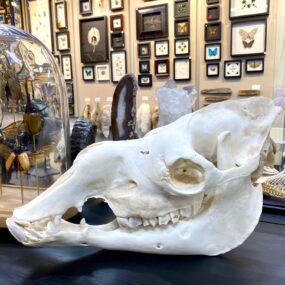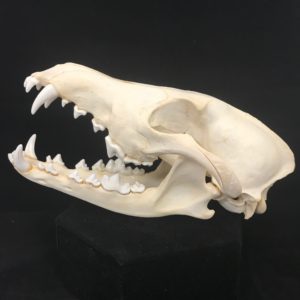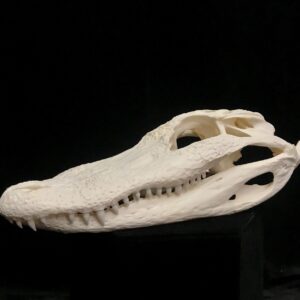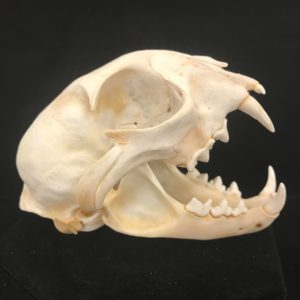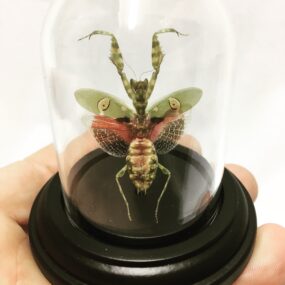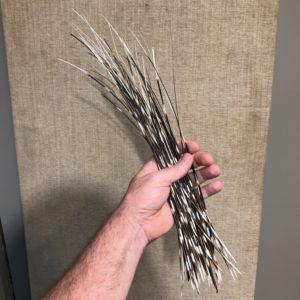Description
Cape Buffalo Skull Specimen
Also referred to as the African buffalo, the adult Cape Buffalo’s horns are its characteristic feature; they can have fused bases, forming a continuous bone shield across the top of the head which is referred to as a “boss”. They are widely regarded as among the most dangerous animals on the African continent, and according to some estimates they gore, trample, and kill over 200 people every year.
The African/Cape buffalo is not an ancestor of domestic cattle and is only distantly related to other larger bovines. Its unpredictable temperament means that the African buffalo has never been domesticated, unlike its Asian counterpart, the water buffalo. African Cape buffaloes have few predators aside from lions and large crocodiles.
Approximate measurements:
Widest point = 30 inches
Tip of horn to bottom of skull = 23 inches
Tip of horn to tip of horn = 19.5 inches
You will receive this specimen, or one like it. We will be happy to send photos of the exact specimen that you will receive.
The **cape buffalo** (*Syncerus caffer*), often referred to as the **African buffalo**, is a fascinating yet dangerous animal native to sub-Saharan Africa. Known for its imposing size, complex social structure, and volatile temperament, it is both an iconic and fearsome creature of the African wilderness. Here’s more about the buffalo’s characteristics, behavior, and why it’s considered one of the most dangerous animals on the continent.
### **Physical Characteristics:**
– **Size:** Adult cape buffaloes are large and robust animals. Males (bulls) typically weigh between 1,000 to 1,500 pounds (450 to 680 kg), while females are generally smaller. They can stand about 4.5 to 5 feet (1.4 to 1.5 meters) at the shoulder.
– **Appearance:** They have a thick, muscular body covered in coarse dark brown to black fur. Their heads are large with broad, heavy horns that form a characteristic, wide, “boss” over the forehead. These horns are a key distinguishing feature, with those of bulls being larger and thicker than those of cows. The horns curve outward, then inward, and can span up to 40 inches (100 cm) across.
– **Eyes and Ears:** Their eyes are often described as deep-set and intense, giving them a watchful and sometimes ominous expression. Their ears are wide and help them communicate and alert others of danger.
### **Behavior and Social Structure:**
– **Herds:** Cape buffaloes are herd animals, typically forming large, tight-knit groups of 20 to 500 individuals. These herds are usually made up of females and young, with males either staying in the herd or forming bachelor groups. Bulls often leave the herd once they reach adulthood and may live alone or in smaller groups.
– **Hierarchy and Cooperation:** There is a clear social structure within the herd, often with a dominant female or lead bull. Herd members cooperate to protect each other, especially the calves. The buffaloes are known to exhibit strong protective instincts, and when under threat, the herd will often circle around the vulnerable individuals, particularly the young or weak.
– **Communication:** They communicate through a range of vocalizations, such as grunts and snorts, as well as through body language and scents.
### **Diet:**
Cape buffaloes are **herbivores**, primarily grazing on grass, but they will also eat shrubs, fruits, and occasionally bark when grass is scarce. They are considered **bulk feeders**, meaning they consume large quantities of food daily. Their diet helps maintain the grasslands by preventing overgrowth.
### **Why They’re Dangerous:**
Cape buffaloes are often considered **one of the Big Five** (along with lions, leopards, elephants, and rhinoceroses) in Africa due to their combination of strength, speed, and unpredictable nature. Here’s why they are so dangerous:
– **Aggressive Behavior:** Cape buffaloes are highly territorial and protective of their herd. They are known to be unpredictable, with a short temper and a tendency to charge at perceived threats, whether it be predators or humans. A buffalo will often not back down once it feels cornered or threatened.
– **Powerful Horns:** Their horns are not just for display but are deadly weapons. They can gore and dismember predators, including lions. If threatened, they can charge with remarkable speed and strength, reaching speeds of up to 35 miles per hour (56 km/h). Their ability to change direction swiftly makes them especially dangerous to anyone who underestimates them.
– **Defensive Nature:** Unlike some other prey animals that may flee when attacked, buffaloes tend to fight back fiercely. They have been known to defend themselves successfully against lions, even killing them in the process. There are documented cases of buffaloes killing lions by goring or trampling them.
– **Fatal to Humans:** While they are generally not aggressive toward humans unless provoked, cape buffaloes are responsible for more human deaths in Africa than most other large animals. They are known to be quick to anger and are highly dangerous when encountered in the wild.
### **Hunting and Conservation:**
– **Trophy Hunting:** The cape buffalo is a popular target for trophy hunting due to its size and strength. The “daggered” bulls, those with particularly large and impressive horns, are especially prized. However, this practice has contributed to the decline in buffalo populations in some areas.
– **Conservation Status:** While the cape buffalo is not currently listed as endangered, it faces threats from habitat loss, diseases like **foot-and-mouth disease**, and poaching. Efforts are underway to protect buffalo populations, particularly through conservation areas and controlled hunting programs.
### **Interesting Facts:**
– **Lifespan:** In the wild, cape buffaloes can live for up to 15 years, though many are taken by predators or succumb to illness before reaching old age.
– **Predators:** While adult buffaloes have few natural predators due to their size and strength, young calves and weak individuals are often targeted by lions, crocodiles, and hyenas.
– **Incredible Memory:** Buffaloes are known for their excellent memory, especially when it comes to dangerous encounters. They can recognize and remember individuals who pose a threat, including humans and predators, and have been observed to retaliate or avoid such individuals in the future.
The cape buffalo’s combination of strength, social cooperation, and aggression makes it both an iconic and formidable presence in Africa’s ecosystems. Its reputation for being dangerous is well-earned, but it’s also a testament to the survival instincts and resilience that allow it to thrive in the wild.
Skull, Snake, Incredible Gaboon viper skull, mounted in a glass dome















